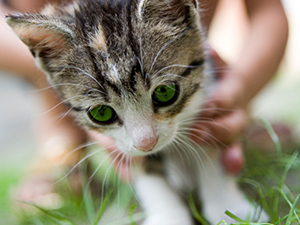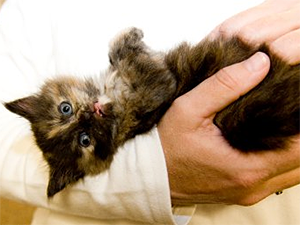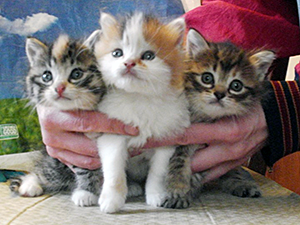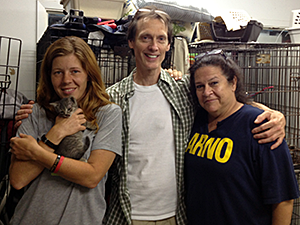
With thousands of kittens and cats already in shelters awaiting adoption, you might ask, “Why tame feral kittens and add to that number?” Increasing the number of cats needing adoption is clearly a concern to weigh against any rationale for taming feral kittens for adoption. That said, taming feral kittens for adoption can support the ultimate success of a Trap-Neuter-Return (TNR) project, improving the quality of life for residents, caretakers, and cats alike.
Removing and taming kittens may, at first, seem to contradict the fundamental mission of TNR. With TNR, members of a cat colony are trapped, spayed or neutered, vaccinated for rabies, eartipped, returned to their homes on the street, and cared for there to live out their lives without reproducing and adding to the overall feral cat population. So, with unconditional support of TNR as a global solution, I would heartily agree that one might choose to neuter, instead of tame, feral kittens and return them to live with their mothers and their colonies with good conscience. A safe outdoor life is enjoyed by many a feral cat who lives to a ripe old age with daily care and an all-weather shelter provided in a safe locale, surrounded by tolerant, if not necessarily compassionate, neighbors. This, of course, is an ideal set of conditions and many colonies thrive even when their devoted caretakers face a far less ideal situation.

To risk offending some hard-working rescuers, I believe strongly that completing the TNR of an entire colony to stop reproduction should always be the primary focus and goal. Unfortunately, flying under the banner of a supposed ongoing TNR project, the practice of “skimming” litters of kittens from a colony that never gets fully neutered is all too common. This is clearly not TNR, but, when the population fails to stabilize, community members will nonetheless view this as a failure of TNR.
However, removing and taming the youngest kittens for adoption when a TNR project is just getting underway, or is still incomplete, can be a good strategy to benefit all concerned.
In places where TNR has been neglected for too long, the large number of cats in the area is often a major complaint of intolerant residents. If the litters of young kittens can be removed from a colony, the noticeable reduction in the number of cats can help improve community relations.

The idea that taming kittens for adoption increases TNR success and colony well-being has taken root in the feral caretaker community, as evidenced by the ongoing and growing popularity of NYC Feral Cat Initiative (NYCFCI) kitten socialization workshops. Over the years, hundreds of TNR caretakers from the New York City area have attended these workshops, conducted by me and/or NYCFCI colleague Valerie Sicignano, to learn techniques for taming those hissing, scratching, and spitting feral kittens.
In case you didn’t know, when under eight weeks of age, these little banshees can be quickly socialized to human contact and then safely placed into the arms of prospective adopters. The first 15 minutes of the workshop is devoted to training attendees to tame kittens less than eight weeks old. The remaining 2 hours and 45 minutes of the workshop is devoted to discussing how to tame older kittens.

 About the Author
About the Author
Mike Phillips, LVT, is the Community Outreach Coordinator for the NYC Feral Cat Initiative of the Mayor’s Alliance for NYC’s Animals. Mike prepares presentations for the general public, trappers, and professional audiences; heads up our community outreach efforts; and responds to requests for information about taming feral kittens, trapping assistance, and feral-friendly spay/neuter resources. Mike is a co-founder of Urban Cat League, a former president of Neighborhood Cats, and has worked as the Veterinary Technician Supervisor at the ASPCA Adoption Center in New York City and worked in the ASPCA Animal Hospital’s ICU and on the ASPCA’s Mobile Spay/Neuter Clinic. His tried-and-true taming techniques are featured in Tough Love: Socializing Feral Kittens, a video used by animal shelters around the world. Mike’s “day job” that pays for all that kitty litter is working for New York City Opera, where he’s a resident stage director.



